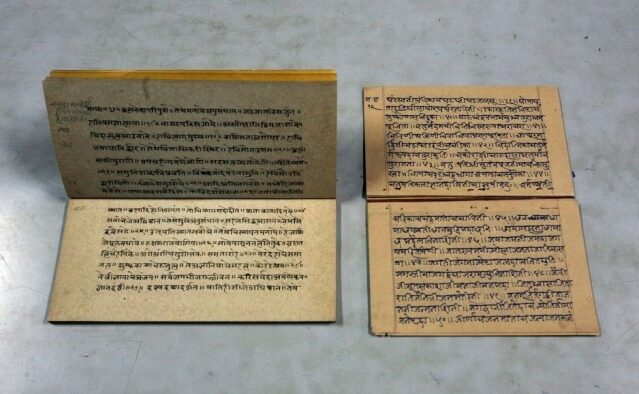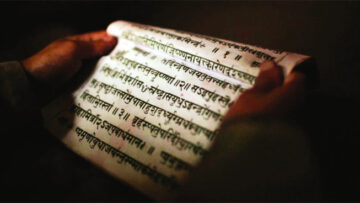“My plea, if there is a plea that I may make, is that those who are the inheritors of a past that they did not create themselves, (viz. Indians), have an obligation to share that past ..with the international scholar community”
Sheldon Pollock on Hindutva and the Life and Death of Sanskrit
“मम याचना, यदि मया याचितव्या हि, अस्ति यत् येऽपि अतीतस्य ऋक्थिनः, यः अतीतः तैः स्वैः (नाम भारतीयैः) न निर्मितः, तम् अतीतम् अन्ताराष्ट्रियविद्वत्सङ्घेन सह भाजयितुं ते उत्तरदायिनः”
शेल्डन्पौलोकः ‘हिन्दुत्व ऐण्ड द लाइफ ऐण्ड डेथ औफ संस्कृत’ इति विषये
Who owns a culture? Is it owned by the people whose ancestors organically developed the culture as a ‘lived experience’ or the colonial progenies who ruled over that society for hundreds of years? Can ‘international scholars’ claim unique academic rights over someone else’s culture while simultaneously silencing native voices?
सभ्यतायाः आधिपत्यं कस्य? तस्य समाजस्य वा यस्य पितरः तस्याः सभ्यतायाः निर्मातारः अथवा आक्रान्तानाम् अपत्यानां यैः सा सभ्यता नैकशतवर्षपर्यन्तं बलाद् निर्जिता शासिता शोषिता च? पाश्चात्त्य-विद्वांसः देशजानां ध्वनीन् मूकीकृत्वा तथा च तेषाम् अवकाशमपि अपाकृत्य तेषामेव संस्कृतिसम्बन्धि-शोधस्योपरि स्वायत्तताम् उद्घोषयितुं शक्नुवन्ति किम्?
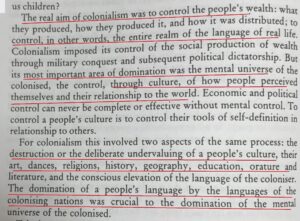 Compared to Indian elites, the African intellectuals have been far more honest and unambiguous in diagnosing and accepting the colonial problem within their newly free nations.
Compared to Indian elites, the African intellectuals have been far more honest and unambiguous in diagnosing and accepting the colonial problem within their newly free nations.
भारतीयबौद्धिकवर्गस्य अपेक्षया अफ्रिकीयबौद्धिकवर्गः स्वस्य नवोदितेषु राष्ट्रेषु पारतन्त्र्यात् जातसमस्यानां स्पष्टतया ईक्षणे स्वीकरणे च अधिक-ऋजुतया व्यवहृतवान्।
Ngugi Wa Thiongo makes a few biting observations in Decolonising the Mind, The Politics of African Literature. He talks about what he calls the ‘Cultural Bomb’ – “the effect of a cultural
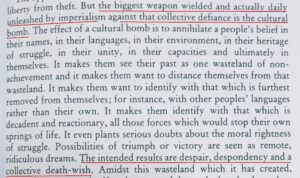 bomb is to annihilate a people’s belief in their names, in their languages, in their environment, in their heritage of struggle, in their unity, in their capacities and ultimately in themselves. It makes them see the past as one wasteland of non-achievement and it makes them want to distance themselves from that wasteland…The intended results are despair, despondency and a collective death-wish.”
bomb is to annihilate a people’s belief in their names, in their languages, in their environment, in their heritage of struggle, in their unity, in their capacities and ultimately in themselves. It makes them see the past as one wasteland of non-achievement and it makes them want to distance themselves from that wasteland…The intended results are despair, despondency and a collective death-wish.”
ङ्गूगि-वा-थियोङ्गो “डिकौलोनाइजिंग द माइण्ड : द पौलिटिक्स औफ एफ्रिकन लिटरेचर” इत्याख्ये पुस्तके कञ्चित् कटाक्षं करोति। ‘संस्कृतिविध्वंसकः’ इति कस्यचित् वस्तुनः विषये सः तत्र वदति। अस्य विध्वंकस्य परिणामो नाम जनानां स्वेषु नामसु भाषासु परिवारेषु सङ्घर्षपरम्परासु एकतायां सामर्थ्येषु अपि च अन्ततः आत्मनि विश्वासस्यापि नाशः। तेन ते स्वातीतम् अनुपलब्धीनां मरुस्थलमिव पश्यन्ति तथा तस्मात् मरुस्थलात् दूरे गन्तुं यतन्ते… फलस्वरूपेण नैराश्यं वैक्लव्यं पुनश्च सामूहिकमृत्योः इच्छा जायते।
How are Indologists producing and setting off these ‘cultural bombs’ in India? Much like in the Hollywood movie ‘Inception’, Indology aims to re-interpret the Indian past and implant their own ideas into the collective Indian subconscious, such that the present Indian reality is but a straightforward extension of the Indologist’s ‘re-imagined’ past. For example, contrary to the traditionally held view of the Indians, if the Mahabharata is ‘shown’ by Indologists as nothing but a mishmash of stories written by many competing authors, how can it continue to be sacred? Shouldn’t it be consigned to the fables and myth section of bookstores? Isn’t Ramayana nothing more than a misogynist Bollywood film story to be analyzed within gender studies departments? If Sanskrit is dead, aren’t all claims Indians have as owners of that dead Sanskritic culture subject to the ‘doctrine of lapse’? In fact, since it was the west who carefully tended and nurtured Sanskrit in Germany, UK and USA, any revivification or resurgence of Sanskrit and related culture in India is clearly artificial, illegitimate and ultimately futile. Voila! Culture Bomb!
कथं भारताध्येतारः भारतेषु एतान् “संस्कृतिविध्वंसकान्” स्फोटयन्ति? ‘इन्सेप्शन्’ इति अमेरिकीयचलच्चित्रे यथा दर्शितं तथैव भारताध्येतारः भारतस्य अतीतं विपरीतं कल्पयित्वा ताः एव कल्पनाः भारतीयानां समष्टिस्मृतौ रोपयितुं यतन्ते, यतः भारतस्य वर्तमानं भारताध्येतृभिः कल्पितस्य अतीतस्य परिणामरूपं दृश्येत। यदि भारताध्येतारः भारतस्य अतीतं व्याख्यान्ति तस्य स्वामित्वं गृह्णन्ति तर्हि त एव वर्तमानस्य वास्तविकतां भूतस्य न्यायसङ्गतपरिणामः इति दर्शयित्वा वर्तमानं साधयितुं शक्नुवन्ति । उदाहरणार्थं पारम्परिकभारतीयमतस्य विपरीतं, भारताध्येतारः महाभारतं नाम नैकैः परस्परस्पर्धालुभिः लेखकैः लिखिताः नैकाः कथाः इति साधयन्ति चेत् कथं नाम तत्र पूजनीयता वर्तेत? तच्च पुस्तकापणेषु काल्पनिककथाविभागे भवितव्यम्। ननु रामायणं स्त्रीद्विट्चलच्चित्रकथाम् अतिरिच्य किं यत् वस्तुतः लिङ्गाध्ययनविभागे परीक्षणीयम्? संस्कृतं मृतं चेत् भारतीयानां कथनं यत् ते मृतसंस्कृतसभ्यतायाः उत्तराधिकारिणः इति “डौक्ट्रिन् औफ् लैप्स्” नामके सिद्धान्ते नान्तर्भवति किम्। वस्तुतः पाश्चात्त्येषु जर्मनी-ब्रिटेन्-अमेरिका-देशेषु संस्कृतं स्नेहेन परिपालितं पोषितम् इति कारणेन भारतेषु संस्कृतस्य पुनरुज्जीवनकार्यं कृत्रिमम् अनैतिकम् अन्ततो गत्वा व्यर्थमेव। अहो बत संस्कृतिविध्वंसकः!
Since 2001, Sheldon Pollock has led the Sanskrit Knowledge Systems on the Eve of Colonialism (SKSEC) project that sought to understand the Indian intellectual milieu just before the
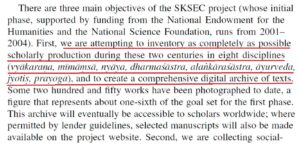 beginning of Western Colonialism. As the SKSEC website states, the objective is to ‘inventory as completely as possible scholarly production during 16th to 18th century in eight disciplines Vyakarana, Mimamsa, Nyaya, DharmaShastra, Alankara-Shashtra, Ayurveda, Jyotisha and Prayoga.’
beginning of Western Colonialism. As the SKSEC website states, the objective is to ‘inventory as completely as possible scholarly production during 16th to 18th century in eight disciplines Vyakarana, Mimamsa, Nyaya, DharmaShastra, Alankara-Shashtra, Ayurveda, Jyotisha and Prayoga.’
२००१तः आरभ्य शेल्डनपौलोकः “उपनिवेशवादे आपन्ने संस्कृतज्ञानप्रणाल्यः” इत्याख्यं प्रकल्पं चालयति। पाश्चात्त्यौपनिवेशवादात् पूर्वं भारतीयबौद्धिकवातावरणस्य अवबोधनं एतस्य प्रकल्पस्य उद्देश्यः। यथा प्रकल्पस्य जालपुटे लिखितमस्ति, “षोडशशताब्दितः आरभ्य अष्टादशशताब्दि-पर्यन्तं व्याकरण-मीमांसा-न्याय-धर्मशास्त्र-अलङ्कारशास्त्र-आयुर्वेद-ज्योतिश्शास्त्र-प्रयोगानां ग्रन्थानां यथासम्भवम् अधिकाधिकं सङ्कलनम्।”
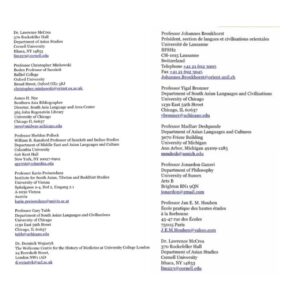
First, let us look at the academic leaders involved in this project.
प्रथमतः अस्मिन् प्रकल्पे संयुक्तान् नेतॄन् पश्यामः।
A. Not a single native research leader is present in this project. The western researchers include all kinds of people from countries like Switzerland, France, Canada, USA, UK, and Austria, all claiming to study the culture and language of India. However, even in areas like Ayurveda or Jyotisha, where brilliant practitioners with deep theoretical and practical expertise are currently present throughout India, we fail to see any sign of these native experts.
क. अस्मिन् प्रकल्पे एकोऽपि भारतीयशोधनेता नास्ति। पाश्चात्त्य-शोधकारेषु स्विसदेशीयाः फ्रान्सदेशीयाः कैनेडावासिनः अमेरिकावासिनः आङ्ग्लदेशीयाः औस्ट्रियावासिनश्च सन्ति ये सर्वे भारतस्य सभ्यताः भाषाः च पठन्ति इति विकत्थन्ते। परन्तु आयुर्वेदक्षेत्रे ज्यौतिषेऽपि यत्र पारङ्गताः अद्वितीयविद्वांसः शास्त्रीयं प्रायोगिकं च ज्ञानं अवधारयन्तः आभारते निवसन्ति तेऽपि अस्मिन् गणे कुत्रापि न दृश्यन्ते।
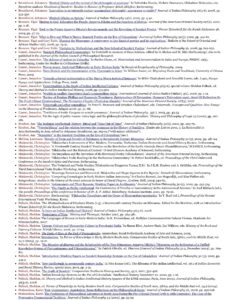
B. Not a single author from an Indian institution is seen in the SKSEC published papers across topics ranging from Ayurveda, Jyotisha, Vyakarana, and Mimamsa.
ख. अनेन संस्थानेन मुद्रितेषु व्याकरणमीमांसाज्योतिषायुर्वेद-विषयक-पत्रेषु एकोऽपि लेखकः भारतीयसंस्थानात् न दृश्यते।
C. Looking at these published articles, the inventory of topics seems like the raw material for an initiative designed to analyze, define and categorize the modern Indian. How come no Indian Pundit is involved in this project? Why is this initiative fully controlled by western universities, even for subjects that are still alive and breathing in contemporary Indian society?
Is this reasonable? Is this ethical?
Is it not a prime example of a cultural bomb?
ग. एतानि मुद्रितलेखनानि दृष्ट्वा प्रतीयते यदेषा विषयसूची नाम आधुनिकभारतीयं परिशीलयितुं निरूपयितुं वर्गीकर्तुं नूतनप्रकल्पस्य बीजम्। कथमस्मिन् प्रकल्पे कोऽपि भारतीयपण्डितः न विद्यते? किमर्थमयं प्रकल्पः सम्पूर्णतया पाश्चात्त्य-विश्वविद्यालयैः नियन्त्रितः? ये विषयाः अद्यत्वेपि भारतीयसमाजेषु जीवन्तः श्वसन्तः वर्धन्ते तेषामपि नियन्त्रणं पाश्चात्त्य-विश्वविद्यालयैः किमर्थम्?
किमिदमुचितम्? किमिदं न्याय्यम्?
किमेतत् संस्कृतिविध्वंसकस्य प्रमुखोदाहरणं नास्ति?
The Weak Alibis and Excuses
निर्बलानि व्याजानि
A common excuse given by Indologists is that Indian Pundits are just not available today in any of these topics. Even if available, they are not truly world class! Let us see if this claim is valid in the context of SKSEC topics like Vyakarana, Mimamsa, Jyotisha and Ayurveda.
सामान्यतया भारताध्येतारः अपदिशन्ति यत् एतेषां विषयाणां भारतीयविद्वांसः अद्यत्वे नैव लभ्यन्ते। सन्ति चेदपि ते विश्वमञ्चे अकुशलिनः। उपरितनप्रकल्पान्तर्गतेषु विषयेषु व्याकरणमीमांसाज्योतिषायुर्वेदेषु किमिदं सत्यं वा इति पश्यामः।
Just for starters, highlighted are three brilliant, highly accomplished practicing Indian scholars who are among the best in the world in their chosen topics. Mani Dravid Sastrigal, Pushpa Dikshit and KV Seshadrinatha Sastrigal are all acknowledged world-class experts who could easily have brought credibility to the research papers and guided the SKSEC team across cultural nuances in Shastras like Jyotisha, Vyakarana, Mimamsa and Ayurveda.
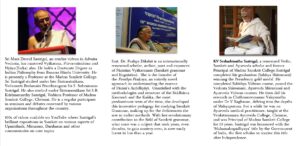
आदावेव अत्रभवन्तः त्रयः विचक्षणाः सिद्धाः उद्यमिनः भारतीयविद्वांसः ये च स्वचितेषु विषयेषु संसारेषु श्रेष्ठाः। मणिद्रविडशास्त्रिवर्याः दीक्षितपुष्पावर्या शेषाद्रिनाथशास्त्रिवर्याश्च त्रयोऽपि सर्वमान्याः प्रतिष्ठिताः विशेषज्ञाः ये च उपर्युक्तप्रकल्पे सरलतया शोधपत्रेषु प्रामाण्यम् आनयेयुः। पुनः प्रकल्प-गणं ज्योतिषव्याकरणमीमांसायुर्वेदेषु सांस्कृतिक-सूक्ष्मांशान् प्रकटयित्वा मार्गं दर्शयेयुः।
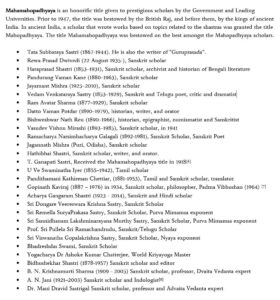
If one were to look at the body of acknowledged Indian experts over the past 100 years, a list of Mahamahopadhyayas (great teachers) would have been a good starting point.
गतानां शतवर्षाणां पूजिताः भारतीयविशेषज्ञाः द्रष्टव्याश्चेत् महामहोपाध्यायानां सूच्या आरम्भः क्रियताम्।
A sample list shown here includes absolute greats like PV Kane (Bharat Ratna 1963) and V V Mirashi to contemporary scholars like Bhadreshdas Swami and Vishwanadha Gopala Krishna Sastry. Given this background, what explains the apartheid that exists between the western academe and the Indian pundits?
अत्र प्रदत्तायां लघुसूच्यां बहवः महान्तः जनाः सन्ति यथा श्रीपीवीकाणे (भारतरत्न-1963) वी-वी-मिराशी आदिभिरारभ्य सम्प्रति भद्रेशदासस्वामी श्रीविश्वनाथगोपालकृष्णशास्त्री इत्यादयः। एवं सत्यपि केन कारणेन पाश्चात्त्यभारतीयपण्डितयोः वर्णभेदः इव भासते।
Another common excuse by Indologists is that since all the key source documents have all been already translated into English, there is no need for native collaborators. We have everything we need, thank you very much…
भारताध्येतृभिः इतोऽपि सामान्यव्याजम् एवमस्ति यत् सर्वे प्रमुखग्रन्थाः आङ्ग्ले अनूदिताः इति कारणेन देशजानां सहयोगः अनपेक्षितः। यत्किमपि आवश्यकं तत् सर्वं अस्ति। बहवो धन्यवादाः।
So, a corollary is: if Indology researchers are relying on western translations, how valid are these translations and interpretations? Do Indian native commentarial traditions agree with the western interpretations? If not, are these translations free of the taint of cultural insensitivity?
अतः एषः प्रतिनिष्कर्षः जायते – यदि भारताध्येतारः पाश्चात्त्यानुवादेषु आलम्बिनः तर्हि तेषां अनुवादाः निष्कर्षाः च कियन्तः मान्याः? भारतीयटीकापद्धतयः तैः निष्कर्षैः सह अनुमन्यन्ते किम्? नो चेत् एते अनुवादाः सभ्यतासंवेदनहीनतावर्णेन न रञ्जिताः किम्?
In addition, for Sanskrit works that are being translated for the first time, are there adequate safeguards in place to incorporate the native voice and perspective?
अपि च याः संस्कृतकृतयः प्रथमवारम् अनूदिताः तेषु देशजानां दृष्टिकोणं सङ्कलयितुं पर्याप्तावसरः अस्ति किम्?
The Skandapurana project, a recent initiative, based on Palm Leaf Manuscripts found in Nepal is interesting to review. The website claims that “We are creating a critical edition of a foundational work of puranic literature. The Skandapurāṇa Project is grounded firmly in the scholarly
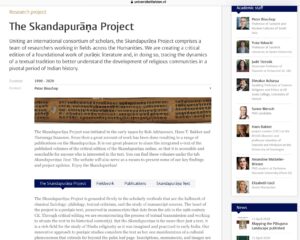 methods that are the hallmark of classical Indology: philology, textual criticism, and the study of manuscript sources.
methods that are the hallmark of classical Indology: philology, textual criticism, and the study of manuscript sources.
सद्यस्कः स्कन्दपुराणसम्बन्धी प्रकल्पः परीक्षणीयः यः नेपालेषु प्राप्तानि तालपत्राणि आश्रित्य क्रियते। तस्य जालपुटे प्रकाशितमस्ति यत् “वयं पुराणसाहित्यस्य आधारभूतग्रन्थस्य परिष्कृतं संस्करणं निर्मामः। अयं स्कन्दपुराणप्रकल्पः प्रतिष्ठित-पद्धतीः आश्रयति याः पारम्परिक-भारताध्ययनस्य गुणवत्ता-सूचकाः यथा ग्रन्थान्वेषणं दोषदर्शनम् अभिलेखानां स्रोतसः परीक्षणं च।”
As per the author(s), the original Nepali scribal errors had to be corrected and lacunae filled wherever damage to the manuscript was encountered. In addition, ‘conjectural emendation’, which is polite terminology for ‘guesswork’
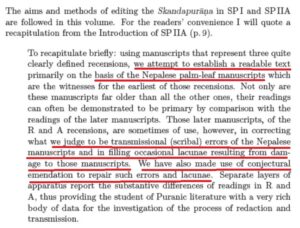 had to be employed. Essentially, the authors have used their ‘judgment’ throughout the project.
had to be employed. Essentially, the authors have used their ‘judgment’ throughout the project.
स्कन्दपुराणप्रकल्पस्य लेखकः (लेखकाः वा) मनुते यत् मूलनेपालीलेखने केचन दोषाः परिष्कर्तव्याः आसन् अपि च यत्र कुत्रापि मूलपाण्डुलिपिः भग्नः आसीत् तत्र तस्य अनुमानेन पूरणं कर्तव्यमासीत्। पुनश्च ‘कञ्जेक्चरल् एमेण्डेशन्’ यत् ऊहस्य अपरनाम एव तत् अपि प्रयोक्तव्यमासीत्। वस्तुतः लेखकाः आसमन्तात् स्वमतिं चालितवन्तः।
Given the claims for this work to be a “Critical Edition’, it is important that all relevant voices and views, including that of the native Pundits be included. Since guess work is involved, it is doubly important to make sure that interpolations, if any, are in sync with the traditional interpretations.
इदं परिष्कृतं संस्करणमिति विज्ञापितमिति कारणेन सर्वेषां समुचितानां विचाराणां विशिष्य भारतीयपण्डितानां दृष्टिकोणस्य सङ्कलनं भवेत्। ऊहापि अत्र कल्पितेति कारणेन यदि योजितांशाः सन्ति तर्हि ते पारम्परिकविवरणेन सह सङ्गच्छेयुः इति निश्चेतव्यम्।
A list of academic staff involved in this project shows folks from universities in Leiden, Kyoto, Lille, Oxford, Groningen, and Paris, but none from Nepal or India.
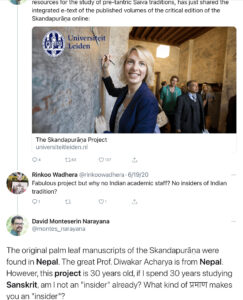
A brief Twitter exchange re: the absence of local Pundits is quite enlightening – “The original palm leaf manuscripts of the Skandapurana were found in Nepal. The great Prof. Diwakar Acharya is from Nepal”.
प्रकल्पेऽस्मिन् कार्यकर्तॄणां सूचिं पश्यामश्चेत् लीडेन्-क्योटो-लिल्ल्-औक्सफोर्ड्-ग्रोनिंजेन्-पैरिस्-आदिभ्यः विश्वविद्यालयेभ्यः जनाः दृश्यन्ते परन्तु न भारतनेपालयोः। स्थानिकपण्डितानाम् अभावविषये एषः कूजनसंवादः द्योतकः “स्कन्दपुराणस्य मूलतालपत्राणि नेपालेषु प्राप्तानि। महान् प्राचार्यदिवाकराचार्यः नेपालतः अस्ति।”
The objective clearly is to claim credibility and moral ascendance by highlighting the presence of a ‘native’ expert in the project team, even though one who is working in Oxford. This is, indeed, praiseworthy.
स्थानीयविशेषज्ञेन प्रामाणिकतां प्राप्तुं प्रयत्नोऽयमिति स्पष्टतया दृश्यते। यद्यपि स औक्सफोर्ड्-मध्ये कार्यरतः तथापि श्लाघनीयमिदम्।
However, a look at the list of publications and authors provides a completely different and confusing picture. The authors include Bakker, Adriaensen, Isaacson, Bisschop, Yokochi, Mirnig, Torzsok, Bosma, and Cecil.
किन्तु यदि प्रकाशनानि लेखकान् च पश्यामः तर्हि विपरीता शङ्कनीया च स्थितिः वर्तते। लेखकेषु बाक्करः आद्रियांसेनः ईसाकसनः बीस्होप्पः योकोची मिर्निग् तोर्सोकः बोस्मा सेसिलः च सन्ति।
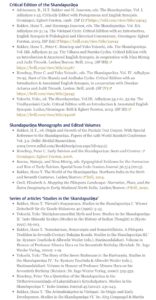
Prof. Acharya is only credited thusly: Introduction and Annotated English Synopis in cooperation with Diwakar Acharya and Judit Torszok’.
आचार्यवर्यस्य नाम केवलं एकस्मिन्नेव स्थाने एवं दीयते, “प्रस्तावना अपि च अङ्कित-आङ्ग्ल-सारसङ्ग्रहः दिवाकराचार्यस्य जुडिट्-तोर्सोकस्य च सहकारेण” इति।
While we certainly are not privy to the work distribution or the reasons as to why Professor Acharya is not among the list of main authors, what explains the absence of traditional Pundits from Nepal or India who have extraordinary expertise in Sanskrit as well as Puranas? What makes the Netherlands based Leiden University believe that it is OK to interpret and translate an important cultural artefact of Nepal and India – without incorporating the critical voice of the native stakeholders?
प्रकल्पस्य दायित्वभाजनं कथमिति, दिवाकराचार्यस्य मुख्यलेखकानां सूचीषु नाम कुतो नास्तीति वा न जानीमः, किन्तु कथमेतद् यत् नेपालस्य महान्तः पण्डिताः संस्कृतज्ञाः पुराणज्ञाः च लेखकसूचीषु अनुपस्थिताः। नेदरलैण्डस्य लेडिनविश्वविद्यालयः किमर्थमेवं चिन्तयेद् यत् नेपालभारतयोः अतिमहत्वपूर्णसांस्कृतिकचिह्नम् अनूदितुं तस्य संस्कृतेः धारकाः नावश्यकाः।
How is it that the same societies that claim that no one should call sparkling wine “Champagne’ or call any cheese ‘Gouda’ take liberties with the cultural patrimony of other societies?
कथम् एत एव समाजाः उद्घोषयन्ति यत् या कापि मदिरा शैम्पेन्-नाम्ना न व्यवहर्तव्या तथैव यत्किमपि चीस्-नाम गौडेति न वक्तव्यं परन्तु अन्येषां समाजानां सांस्कृतिक-पितृधनमपि गम्भीरतया न गृह्णन्ति।
While no one is suggesting that Dutch and other Europeans should not study these topics, just thanking native academicians for help with field work while not having them as an organic part of the research team will certainly not suffice. The onus is on these western universities to meaningfully include native voices and show real empathy and respect for native traditions.
डचादयः यूरोपीयाः एतान् विषयान् पठितुमनर्हाः इति नास्ति कस्यापि अभिप्रायः। परन्तु स्थानिकाध्येतॄणां साहाय्यार्थं धन्यवादार्पणमात्रं कृत्वा शोधसमूहस्य अभिन्नाङ्गत्वेन न स्वीक्रियन्ते चेत् समाधानकरं नास्ति। अयं कार्यभारः पाश्चात्त्यविश्वविद्यालयैः सह अवतिष्ठते यत् ते देशीयध्वनीन् शोधकार्ये सार्थकतया आनयेयुः पुनः देशीयपरम्परां प्रति समुचितं सम्मानमपि दद्युः।
The Modus Operandi
कार्य-प्रणाली
From what has been inspected till now, it is quite clear that controlling Sanskrit is at the heart of the Indological modus operandi. By controlling this deep origin, all that gushes out from that source is dammed up, diverted, bottled and sold in shiny new packaging.
एतावता पर्यवेक्षणेन स्पष्टं दृश्यते यत् संस्कृतस्य नियन्त्रणमेव भारताध्येतॄणां हृद्गुहायां स्थिता प्रणाली। गर्भोद्भवं नियन्त्र्य उत्पन्नं सर्वम् अमृतं संगृह्य कूपीषु संस्थाप्य विक्रेतुकामाः भारताध्येतारः।
But how exactly is this effect achieved? Let us now tie all the threads together and look at the playbook used by Indologists and highlight their foundational claims:
किन्तु कथमेतत् सिद्ध्यति? इदानीं सर्वाणि विभिन्नसूत्राणि बद्ध्वा भारताध्येतारैः प्रयुक्तं मार्गदर्शकपुस्तकं दृष्ट्वा मौलिकसिद्धान्तान् प्रकाशयामः।
A. Sanskrit is dead. No Indian really knows the ancient language. Today, the Sanskrit language expertise resides in Germany, UK and USA
- संस्कृतं मृतम् – एकोऽपि भारतीयः प्राचीनभाषां न जानाति। अद्य संस्कृतविषये निपुणता जर्मनी-अमेरिका-आङ्गलदेशेषु निवसति।
B. Indians cannot do quality research. The abysmal academic standards and lack of Sanskrit expertise do not allow Indians to be considered as serious researchers.
- भारतीयाः गुणवत् अनुसन्धानं न कर्तुं शक्नुवन्ति जघन्य-शैक्षणिक-मानकत्वात् पुनश्च संस्कृते कौशल्याभावात् भारतीयान् गम्भीरशोधकर्तृषु परिगणितुं नैव शक्यते।
C. Traditional Pundits are unreliable and mired in superstition. They are biased and are not able to scientifically and dispassionately analyse their own cultural and religious issues. They also do not understand modern western philological frameworks which is critical for Indology ‘expertise’.
- पारम्परिकपण्डिताः अविश्वसनीयाः अन्धविश्वासिनः च – ते पक्षपातिनः वैज्ञानिकरूपेण निःस्पृहया स्वेषां सांस्कृतिकान् धार्मिकान् च विषयान् विश्लेषयितुम् असमर्थाः। ते आधुनिकभाषाशास्त्रं न जानन्ति येन भारताध्ययनं क्रियते|
D. India is mired in Caste, Religion, and Nationalism. Indians are misusing Sanskrit and culture to inflame religious passions. We need to control it. The Indian fox cannot guard the Sanskrit henhouse and hence the western academia needs to be in charge.
- भारतं जातिधर्मराष्ट्रवादेषु रतम् – भारतीयाः संस्कृतस्य संस्कृत्याः च दुरुपयोगेन मदान्धतां प्रज्वालयन्ति। अस्माभिः तत् नियन्त्रणीयम्। भारतीयशृगालः संस्कृतरूपिणं कुक्कुटीगृहं रक्षयितुं न शक्नोति अतः पाश्चात्त्यविदुषां नेतृत्वम् आवश्यकम्।
Basically, “Sanskrit and Indian Civilization is too important to be left to the Indians.”
मूलतः – “संस्कृतं भारतीयसभ्यता च अतिमहत्त्वपूर्णे न कदापि भारतीयानां हस्तयोः स्थापितव्ये।”
The Indological Superstructure is then built on these axiomatic claims, using a few brilliant tricks of the trade that are designed to exclude and disenfranchise the natives.
भारताध्ययनस्य भवनम् एतैः सिद्धान्तसूत्रैः कपटतया निर्मितं यस्मात् देशीयाः वञ्चिताः बलहीनाः च भवेयुः।
1. The language of discourse is divorced from the native intellectual tradition. To participate in the Indology discourse and critique the ideas, the Indian pundit needs to engage with a superfluous foreign language like German or English and not in the original language of the tradition – Sanskrit. Hence it is critical that Sanskrit is killed off and the discourse occurs in an alien tongue.
- विमर्शस्य भाषा भारतीयबौद्धिकपरम्परायाः विरहिता। भारताध्ययनविमर्शेषु भागं वोढुं भारतीयपण्डितैः जर्मनभाषा उत आङ्ग्लं ज्ञातव्यं न तु सभ्यतायाः मूलभाषा संस्कृतम्। अतः तेषां कृते अत्यावश्यकं यत् जनाः संस्कृतं मृतमिव मन्येरन् यस्मात् वैदेशिकभाषया विमर्शः भवेत्।
2. The core texts are all translated into foreign languages and the foreign texts are now assumed to be gold standards – as good, if not better than the original. Griffith for Vedas, Goldman for Ramayana, Olivelle for Upanishads, Monier Williams for Dictionary are all examples. Native commentary, traditions and interpretations as well as the intellectuals are slowly phased out.
- मूलग्रन्थान् वैदेशिकभाषासु अनूद्य तान् अनुवादानेव इदानीं प्रामाणिकान् मन्यन्ते – परिवर्धितं नास्ति चेत् मूलमिव वा। उदाहरणार्थं वेदानां ग्रिफ्फिथ्, रामायणस्य गोल्डमान्, उपनिषदाम् ओलिवेल्ल्, अपि च शब्दकोशानां मोनियरविलियम्स्। देशीय-टीका-टिप्पणी-व्याख्याः विद्वांसः च शनैः शनैः उञ्झिताः।
3. Referencing for all new research is now made using the foreign translated set of canonical books. To understand and reference the Upanishads, one uses Patrick Olivelle or Joel Brereton rather than Shankaracharya. The views and errors of the translators are now transformed into accepted facts. Tradition is slowly edged out.
- नूतनानुसन्धानानां कृते सन्दर्भाः वैदेशिकानुवादग्रन्थेभ्यः प्रयुज्यन्ते। उपनिषदः अवबोधनीयाः चेत् पाट्रिक् ओलिवेल्ल् अथवा जोल् ब्रेरेटन् पठनीयः न तु शङ्कराचार्यः। अनुवादकानां दृष्टिकोणः त्रुटयः च अधुना ब्रह्मसत्यं भवन्ति। परम्परा शनैः शनैः निरस्यते।
4. A new knowledge production and communication model is deployed via the mechanism of “peer reviewed journals’ in foreign languages. These act as gatekeepers to decide who participates in the discourse and who gets shut out. The traditional modes of debate (Tarka) and Vakyartha Sabhas are ignored and phased out.
- पर्षदीक्षितपत्रिकायाः माध्यमेन वैदेशिकभाषासु विद्योत्सर्जनस्य वार्ताप्रचारस्य नूतना प्रक्रिया संस्थापिता। एतेन माध्यमेन ते द्वारपालकाः इव निश्चिन्वन्ति यत् के भागं वहेयुः के बहिः तिष्ठेयुः इति। पारम्परिकवादप्रकारौ तर्कः वाक्यार्थसभाः च तैः उपेक्षितौ बहिष्कृतौ च।
5. The Indologists now focus not on generating new knowledge, but analysing and taking apart the existing native texts and proving that they are unreliable, cobbled together and wholly problematic. This is diametrically opposite to the goal of the native intellectual tradition which is to interpret and clarify the texts (bhashya/tika) or to create new knowledge.
- नवीनज्ञानोत्सर्जने भारतीयाध्येतृणां रुचिः नास्ति परन्तु केवलं छिद्रान्वेषणे। भारतीयग्रन्थाः अविश्वसनीयाः अनाश्रयार्हाः इति प्रमाणीकरणे तेषां रुचिः। एतस्मात् विपरीता भारतीयपद्धतिः यस्य मूलोद्देश्यं नूतनज्ञानोत्सर्जनं तथा च भाष्येण टीकया वा संशयनिवारणं च।
6. The kind of research ability and skill prized in western Indology becomes similar to that of a dull, plodding financial auditor or housing inspector who has the eagle eyes to spot contradictions between different textual versions and can throw a blizzard of obscure rules and dry facts to raise objections. This approach is alien to the native intellectual culture focused on logical argumentation, creativity, interpretation and new knowledge.
- पाश्चात्त्यभारताध्येतॄणाम् अर्हता निपुणता च नीरसव्यवसायिकलेखापरीक्षकः इवास्ति यः ग्रन्थस्य विविधसंस्करणेषु केवलं छिद्रान्वेषणं जानन् अनेकान् अज्ञातनियमान् शुष्कतथ्यानि च उद्धृत्य आक्षेपान् उद्भावयति। भारतीयबौद्धिकवर्गः अनया विधया अपरिचितः यतो हि अत्र तर्कवादे सृजनात्मकतायाम् अन्वाख्याने नवज्ञानोत्सर्जने च प्रामुख्यं वर्तते।
7. The entire focus of the Indological enterprise finally becomes an unrelenting post-mortem of the culture to tease apart the variations, chop up the pieces and pass judgment on the lack of structure within the ‘decomposed’ cultural body. The Indological objectives are now fully and diametrically opposed to the native traditions – which is to provide a framework for society to function, for individuals to find meaning in life and go beyond the mundane by striving for the sacred.
- भारताध्येतारः आजीवनं केवलं संस्कृतिरूपिणं शवं छिन्दन्ति तस्य कोशान् भिन्दन्ति खण्डान् कर्तयन्ति तदनन्तरं निर्णयन्ति यत् गलिते शरीरेऽस्मिन् सारः एव नास्ति। एतद्विपरीता भारतीयपरम्परायाः पद्धतिः – समाजसंस्थापनायै, व्यष्टेः जीवनोत्कर्षाय, सामान्यात् परं गत्वा परात्परस्य अनुसन्धानाय च।
In this process, the Indological enterprise ends up privileging a vast army of glorified Sanskrit-trained western clerks who are trained to dig out contradictions and errors in texts while plodding through hundreds of ‘source documents.’ They can reel off reams of abstruse, tangential information, but not convey important meaning and context while being only interested in the decomposition and destruction of the subject of study – in other words, necrophilia at its best!
अस्यां प्रक्रियायां भारताध्ययनसङ्घः वस्तुतः अनेक-पाश्चात्त्य-संस्कृतलिपिकारेभ्यः प्रामुख्यं दास्यति ये नैकशतेभ्यः मूलग्रन्थेभ्यः अपवादान् दोषान् च अवचेतुं प्रशिक्षिताः। ते दुर्लभसूचनाः असम्बद्धविषयान् च झटिति प्रकटयन्ति किन्तु सारगर्भितं सन्दर्भानुकूलं ज्ञानं नोद्भावयन्ति परन्तु ग्रन्थान् खण्डयित्वा नाशयितुम् इच्छन्ति। तेषां विषयाणां मृतदेहम् अत्तुमिच्छन्ति।
It is doubly delicious that few, if any, of these clerks and goblins trained for a specific narrow purpose, this formalin fixing of living culture, can communicate or debate meaningfully in Sanskrit. This is the western equivalent of the Indian ‘‘Rapidex certified spoken English’ masses who cannot blurt out even one sentence in English apart from ‘what is your good name, dear sir’?
मनः इतोऽपि मोदते ज्ञात्वा यदेते भारताध्येतृरूपिणः प्रशिक्षितलिपिकाराः संस्कृतभाषया जल्पितुं अथवा सार्थकतया विवक्तुं च प्रायः न शक्नुवन्ति। रैपीडेक्स-आङ्ग्ल-शिक्षण-पुस्तकस्य पाश्चात्त्यरूपम् इव केवलं मम नाम जौनः भवतः नाम किम् इतिमात्रं वक्तुं शक्नुवन्ति।
The Worm Turns: Pushback
निर्बलस्य प्रतीकारः
As a response to this deeply immoral and unjust situation, there has been a pushback by western-trained intellectuals who embody the traditional Indian stance. They use the Indological framework itself to respond to the moral issues and structural racism inherent within the western tradition. Prof. SN Balagangadhara and his group in Ghent, Rajiv Malhotra and the Infinity Foundation and Profs. Vishwa Adluri and Joydeep Bagchee are a few examples of this response. Inspired and supported by the pioneers, there are many newer researchers and scholars who are starting to dig deep into Indology and ask penetrating questions.
एतस्याः अन्यायपूर्णायाः अधार्मिक्याः स्थित्याः प्रतीकारः आरब्धः पाश्चात्त्यप्रशिक्षितैः भारतीयभावावबोधकैः पण्डितैः। ते भारताध्ययनस्य तन्त्रेणैव पाश्चात्त्यपरम्परायां निहितस्य वर्णभेदस्य अधार्मिकतायाः च प्रतीकारं कुर्वन्ति। उदाहरणार्थं घेण्टस्थः प्राचार्यः एस-एन-बालगङ्गाधरः सहकारिणश्च इन्फिनीटीफौण्डेशनस्य श्रीराजीवमल्होत्रः प्राचार्यः विश्वः अडलूरी जयदीपबागची चेति। एतैः प्रचोदिताः अन्ये नैके अनुसन्धानकर्तारः विद्वांसः च भारताध्ययनस्य गुह्यम् अधीत्य कटुप्रश्नान् पृच्छन्तः आसते।
An example is the recently published “An analysis of some aspects of chronology in the Early Upanishads” by Megh Kalyanasundaram (August 2020) which looked at some of the claims made by Patrick Olivelle in his acclaimed book “The Early Upanishads: Annotated Text and Translation”.
उदाहरणार्थं मेघकल्याणसुन्दरेण नवमुद्रितं पत्रं “ऐन् अनालिसिस् औफ् सम् ऐस्पेक्ट्स् औफ् क्रोणोलौजी इन् द अर्ली उपनिषद्स्” इत्याख्यम्। अस्मिन् पुस्तके तेन पैट्रिक-ओलिवेल्लस्य “द अर्ली उपनिषद्स्: ऐन्नोटेटेड् टेक्स्ट् ऐण्ड् ट्रान्स्लेशन्” आख्य-पुस्तकस्थानि कानिचन वचनानि निराकृतानि।
Professor Olivelle has been hailed by Dominik Wujastyk, a well-known Indologist as “the world’s leading authority on the history of Indian dharma”. Given such a tall claim
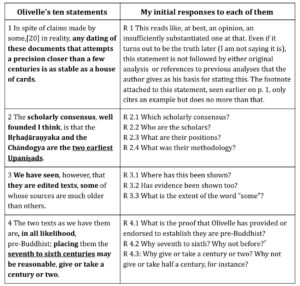 Kalyanasundaram picks up ten statements from Olivelle’s book and raises direct questions regarding the evidence and logic behind each of those statements.
Kalyanasundaram picks up ten statements from Olivelle’s book and raises direct questions regarding the evidence and logic behind each of those statements.
डोमिनिकवुजास्तिकः पाट्रिक-ओलिवेल्लं भारतीयधर्मस्य इतिहासस्य अग्रणी विद्वान् इति प्रशंसितवान्। एवं सति कल्याणसुन्दरः तस्य पुस्तकस्य दशवाक्यानि अवचिनोति अनन्तरं प्रत्येकं प्रमाणं विवेचना च पृच्छति।
A glance at the table shown here highlights that for all the claims of meticulousness and
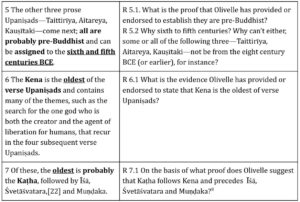 attention to detail that Indologists apparently possess, the evidence behind such sweeping claims is often very thin on the ground.
attention to detail that Indologists apparently possess, the evidence behind such sweeping claims is often very thin on the ground.
अत्रस्थां सारणीम् ईषदेव दृष्ट्वा ज्ञायते यत् यद्यपि भारताध्येतॄणां निपुणतायाः सूक्ष्मदृष्टेः चर्चा बहुधा क्रियते तथापि सारण्यामुक्तवाक्यानां प्रमाणानि कम्पमानभूमौ तिष्ठन्ति।
In fact, it is a bit embarrassing that substantial claims are being made by using throwaway schoolboy phrases such as ‘In all likelihood’, ‘the scholarly consensus is’, ‘they probably are’, ‘they are edited texts’ etc.
लज्जास्पदमिदं यत् गम्भीरवाक्यानाम् उपस्थापनं केवलं बालिशानि वचनानि आधृत्य क्रियते यथा ‘भवितुमर्हति’, ‘विद्वांसः कथयन्ति’, ‘स्यात्’, ‘तानि सम्पादितानि शास्त्राणि’ इत्यादीनि।
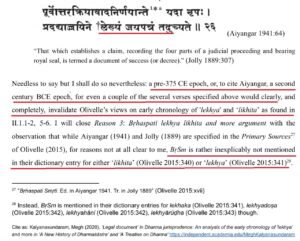
These new Indian scholars are highlighting errors of omission and commission in books and published articles by these acclaimed western Indological experts. In addition to errors, controversial new claims made by the Indological establishment are also being scrutinized and the authors put on notice.
एते अभिनवभारतीयविद्वांसः प्रसिद्ध-पाश्चात्त्य-कुशलभारताध्येतृभिः प्रकाशितेषु पुस्तकेषु मुद्रितलेखनेषु च कृतान् दोषान् प्रकाशयन्ति। किं बहुना भारताध्ययनतन्त्रैः प्रतिपादितान् विवादास्पदसिद्धान्तान् सम्यक्तया परिशीलयन्तः तान् लेखकान् सञ्चेतयन्ति।
As an example, Mark McClish, a student of Patrick Olivelle claims that Arthashastra was not written by Vishnugupta Chanakya and that it is actually a mishmash of multiple texts.
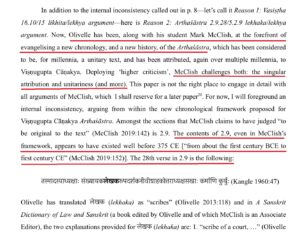 Megh Kalyanasundaram (2020) has raised a series of arguments against this proposition that certainly deserve a respectful response and meaningful debate from the Indological establishment.
Megh Kalyanasundaram (2020) has raised a series of arguments against this proposition that certainly deserve a respectful response and meaningful debate from the Indological establishment.
उदाहरणार्थं पाट्रिक्-ओलिवेलस्य छात्रः मार्क्-मेक्लिशः वितण्डावादं करोति यत् अर्थशास्त्रग्रन्थः विष्णुगुप्त-चाणक्येन न लिखितः परन्तु अनेकानां ग्रन्थानां मिश्रकृतिरिति। मेघ-कल्याणसुन्दरेण (२०२०) एनां दुरुक्तिं खण्डयितुं प्रत्युत्तराणाम् आवलिरेव रचिता यस्यै भारताध्ययनतन्त्रात् उत्तरं तथा च सार्थकवादः अपेक्ष्यते।
It is interesting that the Indological establishment has not yet responded meaningfully to any of these valid criticisms and seems to be shying away from engaging with these challenges from the Indian scholars. There is also no response to queries around their claimed expertise in Sanskrit, Indian Cultural understanding, training in Shastras as well as issues of motivations and objectives behind their current research processes and practices.
अवधेयं यदेतद् भारताध्ययनतन्त्रम् एतावत् पर्यन्तं सदाक्षेपान् सार्थकतया नोत्तरितवत्। पुनश्च भारतीयविद्वद्भिः सह वादे भागं वोढुमपि लज्जते। तेषां संस्कृतभाषाकौशले भारतीयसंस्कृतिज्ञाने शास्त्राध्ययने कृतानां प्रश्नानामपि उत्तरं न प्राप्तम्। अपि च तेषां सद्यस्कानां शोधपद्धतीनाम् उद्देश्यं कारणमपि न ज्ञायते।
The Coda
अन्ततः
A few final questions for us to ponder.
केचन विचारणीयाः प्रश्नाः।
- Is the refusal by Indologists to publish in Sanskrit because of a niggling fear that if the original experts can read and criticize the articles, the claim of Sanskrit ‘scholarship’ and meticulousness will get called out in a jiffy?
- यदि भारतीयसंस्कृतपण्डिताः तेषां पत्राणि पठितुं शक्नुवन्ति तर्हि तेषां संस्कृतविषयकम् अज्ञानं सर्वत्र प्रकाशते – किं वा अनया भीत्या भारताध्येतारः संस्कृतेन प्रकाशनं न कुर्वन्ति?
- Are the lack of Sanskrit debates, speeches and articles by Indologists primarily driven by a fundamental inability of most Indologists to speak in fluent and chaste Sanskrit with the right accent? Will they come off looking like amateurs if they start speaking in the language they are studying – Sanskrit?
- भारताध्येतृभिः संस्कृतेन वादविवादानाम् आख्यानानां पत्राणाञ्च अनुपलब्धता किं तेषां संस्कृतसम्भाषणस्य असमर्थतां द्योतयति? यदि ते स्वीयया अध्ययनभाषया वक्तुं प्रयतेरन् तर्हि संस्कृतविषये एव अपरिपक्वाः इव भासेरन् वा?
- Is the unwillingness to debate with Indian Pundits driven by lack of expertise to debate in the traditional Indian manner, contrary to all the handwaving and learning-by-debate claims?
- भारतीयपण्डितैः सह परिचर्चां कर्तुं तेषाम् अनिच्छा एतेन कारणेन तु नास्ति यत् ते भारतीयविधिना विमर्शं न जानन्ति? परन्तु तदा वादपद्धत्या शिक्षणं प्राप्तवन्तः इति मिथ्याकथनं सिद्ध्यति।
- Is the narrow specialization focus of the Indologists causing them to be wary of debating against the broad and holistic education of the traditional pundit?
- ननु भारताध्येतॄणां सङ्कीर्णायाः एकदेश-कुशलतायाः कारणेन विस्तृत-सार्वभौम-शिक्षणप्राप्तेन पारम्परिक-भारतीय-विद्वांसेन सह तर्कयितुं ते उदासीनाः?
- Is the demand that Indian Pundits travel to western universities to debate in English or German, certain fundamental questions regarding their own Culture and Language, nothing more than a deeply unjust and unfair mechanism to enforce apartheid?
- भारतीयपण्डिताः पाश्चात्त्यविश्वविद्यालयेषु गत्वा आङ्ग्लेन उत जर्मनभाषया तैः सह विमर्शं कुर्युः इति अनुरोधः वर्णभेदं प्रतिपादयितुं प्रयत्नः तु नास्ति?
- Is the insistence that Indian Pundits publish in peer reviewed journals controlled by the western academe a mechanism to control unwanted and uncomfortable truths?
- भारतीयपण्डिताः वैदेशिकैः नियन्त्रित-पर्षदीक्षितपत्रिकासु लेखान् प्रकाशयेयुः इति हठः ते कटु-सत्यानि नियन्त्रितुमिच्छन्ति इत्यतः वा?
- If the field is opened for a robust discussion and debate, will the fragile Indological frame buckle and cause the entire superstructure to come crashing down?
- स्पष्टः सुदृढः विमर्शः क्रियते चेत् भारताध्ययनस्य दुर्बल-पञ्जर-भवनं सहसा तु न अधः पतिष्यति?
In fact, are we justified in thinking that the real fear of the Indologist is that we may be starting to see the “The Death of Indology”?
ननु “भारताध्ययनस्यैव मरणं” भारताध्येतॄणां वास्तविकभीतिः इति चिन्तयामश्चेत् सङ्गच्छते किम्?
The End.
समाप्तम्
References
सन्दर्भाः
Sheldon Pollock on Hindutva and the Life and Death of Sanskrit-Part 2: https://www.youtube.com/watch?v=Mk8WVyyyst8
http://www.columbia.edu/itc/mealac/pollock/sks/
https://www.advaita-vedanta.org/mullaivasal/mani_dravid.html
https://youtu.be/QnD3DfVJ4JM
http://www.pushpadikshit.com/award.htm
https://www.thehindu.com/society/history-and-culture/in-conversation-with-multifaceted-kv-seshadrinatha-sastrigal/article26863079.ece
https://en.wikipedia.org/wiki/Mahamahopadhyaya
https://www.universiteitleiden.nl/en/research/research-projects/humanities/the-skandapur%C4%81%E1%B9%87a-project#tab-1
Skandapurana III: https://brill.com/view/title/24008
https://www.academia.edu/43761472/An_analysis_of_some_aspects_of_Chronology_in_The_Early_Upani%E1%B9%A3ads_and_some_observations_of_consequence_to_the_Global_History_of_Philosophy_before_c_500_BCE
https://www.academia.edu/44681929/_Legal_document_in_Dharma_jurisprudence_An_analysis_of_the_early_chronology_of_lekhya_and_more_in_A_New_History_of_Dharma%C5%9B%C4%81stra_and_A_Treatise_on_Dharma
Explore Silence of the Lambs Part I
Featured Image Credits: swarajyamag – Specimen of Sanskrit handwritten manuscripts. (Kalpak Pathak/Hindustan Times via GettyImages)
Disclaimer: The opinions expressed in this article belong to the author. Indic Today is neither responsible nor liable for the accuracy, completeness, suitability, or validity of any information in the article.

